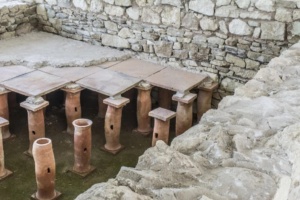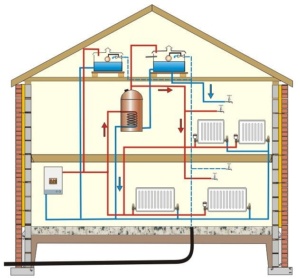Temperature environment is as necessary and important for human existence as air, water and food. Taking care of warmth, which is one of the basic human needs, our ancestors started a long time ago. If getting heat is a simple process for us today and with the help of modern devices, we get the desired result with a click of a finger, it was not so easy for our ancestors who bravely fought against winter and cold. It has been a long journey of continuous human effort, interesting findings and discoveries that have made heating so comfortable and easily accessible to everyone. Centuries ago, we improved, refined, simplified flexible technologies, and today we pride ourselves on modern systems.
Let's take a look at the past - how heating systems have evolved and how the first findings in the history of mankind remain the best ideas to this day.

When we think of heat, fire is probably the first thing that comes to mind. Initially, it was used for heating, food and household tools. Later, man started making stone and clay ovens. This was followed by central water and air heating systems. The ancient Greeks and Romans are considered the pioneers of the heating system. BC year In the city of Ephesus (today's Turkey), founded in the 10th century, a boiler was used for heating, which was located in the basement of the building and was connected to each space of the building by pipelines and supplied the energy needed for heating.
"Everything new that is well forgotten is old" - we can say this about modern underfloor heating. If we delve into the innards of the mentioned system, we will learn the following: - The most efficient model among modern heating systems was called hypocaust in ancient Rome (Greek Hypo - under, below; kaustos - hot, heated). It was the first underfloor heating system.

It was in ancient Rome BC. It appeared in the III-IV centuries. The building was heated by special channels laid in the floor and walls, in which the hot flue gases from the furnace were supplied. This system was first used in public baths, which were widespread in ancient Rome and Greece, and then in European and Asian countries. The hypocaust system was in gymnasiums, hotels, public buildings, etc.
It is worth noting that in Georgia, in Mtskheti region, in the baths and temples-palaces discovered as a result of the excavations of Gultsi Nakalakari (2nd BC - 8th century AD) and Armaziskhevi (2nd - 3rd century AD) for heating purposes, There was a hypocaustic heating system.
Parallel to the Romans, the central heating system, the so-called Kang (kang) is found in China and ondol in Korea. These systems are similar to the Roman hypocaust and are still used in these countries today.

Central heating systems created in Rome in the Middle Ages (VI-XV centuries) were forgotten. The development of similar technologies was no longer paid attention to. Central air heating through air ducts was mainly used to heat castles, monasteries, temples and other public buildings. During this period, stoves and fireplaces were mainly used as a source of heat, initially made of clay and brick, and then metal. In contrast to open fire, a smoke pipe was also added to them. Shorenkets (tile) stoves made of ceramics spread in Europe, which significantly improved their thermal use. In 1741, in the USA, Benjamin Franklin invented a stove that was much safer than its predecessors, better at retaining and releasing heat.

In 1675, the English scientist John Evelyn developed a water heating system for heating the orangery, where water was heated in a boiler and circulated through steel pipes to transfer heat. In 1770, James Watt used steam to heat the factory building, and cast iron radiators as heat transfer surfaces. At the same time, cast iron boilers appeared in England. Coal also began to be used from the middle half of the nineteenth century, Dr. Thomas Walker was the first to discover and use coal for these purposes (Kentucky, USA). Despite the development of heating systems, local heating still dominated as a simpler and cheaper means.
From the end of the 19th century, the development of central heating systems begins in Europe and the USA. At the same time, the production of cast iron boilers and radiators begins.
Since the 20th century, central heating has been widely introduced in many countries of the world, including Georgia. Initially, steam central heating systems were mainly used in public, industrial and multi-storey residential buildings. Thermal generators (boilers) were installed directly in the basements of buildings to be heated. Steam systems were gradually replaced by water heating systems.

During the world's first energy crisis (in 1973), the USA and the developed countries of Europe began to think about saving fossil heating. The search for alternative energy sources and measures to save energy consumption have been started.
Today, for the purpose of heating in many countries of the world, both fossil heating (natural gas, liquid heating, coal) and renewable energy (firewood, biogas, environmental energy, etc.) are used. New technology and modernization have improved heating systems over the years, and now we have many effective options for heating the home.
In today's reality, when it comes to the heating system, we have quite a variety of choices, both on internal heating devices and on the ways of receiving the heating energy itself.

Today's technology allows us to get heating energy from natural gas, to use geothermal energy, with heat pumps we can get air-air, air-water, water-air and water-water system combinations. We can use different types of refrigerant systems, underfloor and air heating systems. All the above-mentioned systems have advantages and disadvantages, therefore, when planning a heating system for a specific building or institution, its functionality, geographical location, environmental conditions, etc. are of great importance. Based on the above, proper and effective planning should be done by qualified personnel in order to obtain energy-efficient and long-term well-functioning technology.

